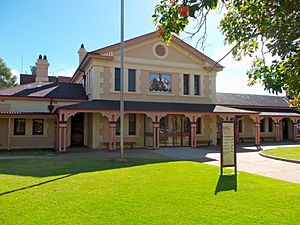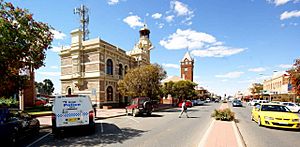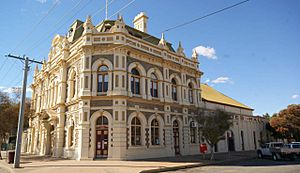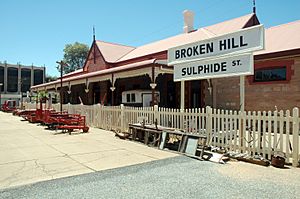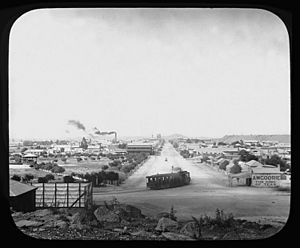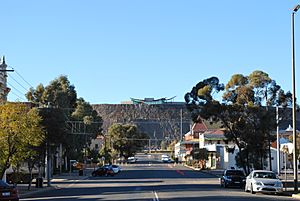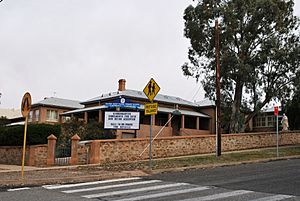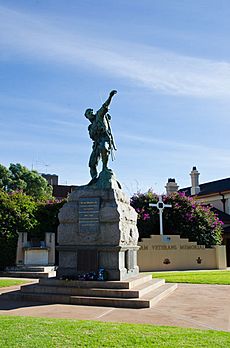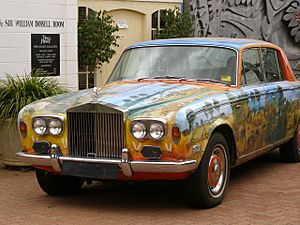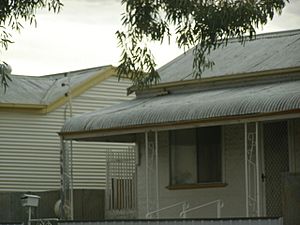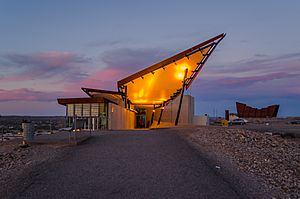Broken Hill facts for kids
Quick facts for kids Broken HillNew South Wales |
|||||||||
|---|---|---|---|---|---|---|---|---|---|

Argent Street, Broken Hill's main street
|
|||||||||
| Population | 17,734 (2018) | ||||||||
| Established | 1883 | ||||||||
| Postcode(s) | 2880 | ||||||||
| Elevation | 315 m (1,033 ft) | ||||||||
| Time zone | ACST (UTC+9:30) | ||||||||
| • Summer (DST) | ACDT (UTC+10:30) | ||||||||
| Location | |||||||||
| LGA(s) | City of Broken Hill | ||||||||
| County | Yancowinna | ||||||||
| State electorate(s) | Barwon | ||||||||
| Federal Division(s) | Parkes | ||||||||
|
|||||||||
Broken Hill is an inland mining city in the far west of outback New South Wales, Australia. It is near the border with South Australia on the crossing of the Barrier Highway (A32) and the Silver City Highway (B79), in the Barrier Range. It is 315 m (1,033 ft) above sea level, with a hot desert climate, and an average rainfall of 235 mm (9 in). The closest major city is Adelaide, the capital of South Australia, which is more than 500 km (311 mi) to the southwest and linked via route A32.
The town is prominent in Australia's mining, industrial relations and economic history after the discovery of silver ore led to the opening of various mines, thus establishing Broken Hill's recognition as a prosperous mining town well into the 1990s. Despite experiencing a slowing economic situation into the late 1990s and 2000s, Broken Hill itself was listed on the National Heritage List in 2015 and remains Australia's longest running mining town.
Broken Hill, historically considered one of Australia's boomtowns, has been referred to as "The Silver City", and less commonly as the "Oasis of the West", and the "Capital of the Outback". Although over 1,100 km (680 mi) west of Sydney and surrounded by desert, the town has prominent park and garden displays and offers a number of attractions, such as the Living Desert Sculptures. The town has a high potential for solar power, given its extensive daylight hours of sunshine. The Broken Hill Solar Plant, which was completed in 2015, is one of the largest in the Southern Hemisphere.
In the Broken Hill region the major aboriginal languages are the Paakantji, Mayyankapa, and Nyiimpaa.
Contents
Time Zone
Unlike the rest of New South Wales, Broken Hill (and the surrounding region) observes Australian Central Standard Time (UTC+9:30), the same time zone used in South Australia and the Northern Territory. This is because at the time the Australian dominions adopted standard time, Broken Hill's only direct rail link was with Adelaide, not Sydney. Similarly, Broken Hill is regarded as part of South Australia for the purposes of postal parcels rates, and telephone charges. BH also used to be a break of gauge station where the state railway systems of South Australia and New South Wales met.
Town name
Broken Hill is Australia's longest-lived mining city. In 1844, the explorer Charles Sturt saw and named the Barrier Range, and at the time referred to a "Broken Hill" in his diary. Silver ore was later discovered on this broken hill in 1883 by a boundary rider named Charles Rasp. The "broken hill" that gave its name to Broken Hill actually comprised a number of hills that appeared to have a break in them. The broken hill no longer exists, having been mined away.
The area was originally known as Willyama.
Prior to Sturt's naming, the surrounding area was referred to by the local Aboriginal population as the "Leaping Crest".
Geology
Broken Hill's massive orebody, which formed about 1,800 million years ago, has proved to be among the world's largest silver–lead–zinc mineral deposits. The orebody is shaped like a boomerang plunging into the earth at its ends and outcropping in the centre. The protruding tip of the orebody stood out as a jagged rocky ridge amongst undulating plain country on either side. This was known as the broken hill by early pastoralists. Miners called the ore body the Line of Lode. A unique mineral recently identified from Broken Hill has been named Nyholmite after one of the city's famous sons Ron Nyholm (1917–1971). Lead with the isotope signature of the Broken Hill deposits has been found across the entire continent of Antarctica in ice cores dating back to the late nineteenth century.
History
The earliest human settlers in the area around Broken Hill are thought to have been the Wiljakali Indigenous Australians, once thought to have only intermittently lived in the area because of the lack of permanent water sources, but it has since been found that the Indigenous Clans of the area were able to survive on underground water holes and wells that were unknown to the European settlers. Many of these waterholes are still kept secret from non-Indigenous people. As in much of Australia, a combination of disease and aggression by white settlers drove them from their lands.
The first white settlers to visit the area was then Surveyor General of New South Wales, Major Thomas Mitchell, in 1841. Three years later in 1844, the explorer Charles Sturt saw and named the Barrier Range while searching for an inland sea; so naming it because it was blocked to his journey north. Burke and Wills passed through the area on their famous 1860–61 expedition, setting up a base camp at nearby Menindee. Pastoralists first began settling the area in the 1850s, and the main trade route to the area was along the Darling River.
Broken Hill was founded in 1883 by boundary rider Charles Rasp, who patrolled the Mount Gipps fences. In 1883 he discovered what he thought was tin, but the samples proved to be silver and lead. The orebody they came from proved to be the largest and richest of its kind in the world. Rasp and six associates founded the Broken Hill Proprietary Company (BHP), later BHP Billiton, in 1885 as the Syndicate of Seven. By 1915 BHP had realised that its ore reserves were limited and begun to diversify into steel production. Mining at the BHP mines at Broken Hill ceased 28 February 1939.
BHP was not the only mining operation at Broken Hill though, and mining continued at the southern and northern ends of the Line of Lode. Currently the southern and northern operations are run by Perilya Limited, who plan to open further mines along the Line of Lode.
The Battle of Broken Hill took place on New Year's Day 1915 when two Afghan men fired upon a trainload of people who were headed to a New Years Day picnic. Since Australia was at war at the time with the Ottoman Empire, the men were first thought to be Turkish, but were later identified as being from the British colony of India (modern day Pakistan). They killed four and wounded six, before they were killed by a group of policemen and soldiers.
In 1918 the Italian Ambassador to Australia, Emilio Eles, with the help of the Australian police and the army, organised the roundup of Italian deserters working there as miners, to be forcibly sent back to Italy to fight in the war.
It is also known for its input into the formation of the labour movement in Australia, and has a rich trade union history. Some of the most bitter industrial disputes have been fought in Broken Hill in 1892, 1909 and 1919. The last of these led to the formation in 1923 of the Barrier Industrial Council, a group of 18 trade unions, which became one of the most influential organisations in the politics of the city. Like many "outback" towns, Broken Hill was built on precious metals, having once had the world's richest deposits of lead, zinc and silver. Although now depleted somewhat, mining still yields around two million tonnes annually. Some mine tours are available. Sheep farming is now one of the principal industries in the area and there are considerably more sheep than people — almost 2 million Merino sheep.
On 10 January 2007, the Broken Hill City Council was dismissed by the New South Wales Minister for Local Government following a public inquiry.
Transport
The city's isolation was a problem until the Adelaide narrow gauge railway link was finished in 1888. Since the New South Wales Government would not allow the South Australian Government to build a railway across the border, the last 31 kilometres (19 miles) were built by a private company as the Silverton Tramway. The line was so named because it was originally intended to serve the mining town of Silverton, but by the time the railway reached the town it was already being eclipsed by the newer and bigger mine at Broken Hill. The main purpose of the railway was to transport concentrates and ores from the mines to the smelters and port facilities on the coast at Port Pirie, South Australia. As a backload to Broken Hill it transported supplies, principally coal for boilers at the mines and timber for the timber sets used underground in mining. The Silverton Tramway Company was the most profitable railway company on the Australia Stock Exchange.
The main sidings and locomotive servicing facilities were in Railwaytown, a suburb of Broken Hill, with sidings running to the south and north to serve the mines. The main passenger station was at Sulphide Street.
From the later 1890s, Broken Hill Council campaigned for a tramway to provide public transport around town and to the mines. Eventually the NSW Government decided to build a tramway which was opened on 19 March 1902. It was run by steam trams transferred from Sydney by sea and then by rail across South Australia. It was a curious operation which after World War I suffered increasingly bad losses until the New South Wales Government closed the system in December 1926.
Another curiosity was the Tarrawingee Tramway which was a narrow gauge railway line which ran north from Broken Hill for about 40 miles (64 km) to an area of limestone deposit which was quarried and transported to Broken Hill for use in the smelters at the mines. The tramway opened in 1891 but closed in 1898 as the smelters moved to Port Pirie. In 1889 the Public Works Committee of the New South Wales Legislative Assembly recommended that the Government take over the line and it subsequently became a narrow gauge part of the New South Wales Government Railways (NSWGR) run under contract by the Silverton Tramway Company.
It was an excursion train on the Silverton Tramway that was fired on by two Afghan immigrants in 1915 (see Battle of Broken Hill).
In 1919, a 1,435 mm (4 ft 8 1⁄2 in) standard gauge rail link from Broken Hill to Menindee was opened to transport water from the Darling River to Broken Hill. It was built as the first stage in a planned direct route to Sydney. The terminus for the train was at Crystal Street station, some distance from the Silverton Tramway Company's Sulphide Street station. The railway mainly hauled water from the Darling River. The rolling stock all had to be transported by sea to South Australia and the railway was supervised by the superintendent of the Broken Hill Government Tramways.
In November 1927 the direct link to Sydney was completed. In September 1937 the NSWGR placed into service the Silver City Comet, the first air conditioned train in Australia, which ran between Broken Hill and Parkes.
During World War II, land transportation between South Australia and Eastern Australia became important because of the threat posed by submarines and mines to coastal shipping. Extensive transshipment yards were constructed at Broken Hill in 1942 to allow transshipment of munitions. However, the threat was never fully realised.
With the purchase of the Sulphide Corporation by the Zinc Corporation in 1948, the modern Cockle Creek Smelter was constructed south of Newcastle. This started to take lead and zinc concentrates directly from Broken Hill via rail in the 1960s, marking the first major use of the rail link to NSW. This was the well known W44 Concentrate Train.
In 1970 the 1,067 mm (3 ft 6 in) gauge railway from Port Pirie to Broken Hill was superseded by a new 1,435 mm (4 ft 8 1⁄2 in) gauge line, mostly laid alongside the narrow gauge line. This completed the standard transcontinental gauge line from Sydney to Perth.
Broken Hill railway station is one of the stops of the Indian Pacific passenger service, operated by the Journey Beyond, from Sydney to Perth via Adelaide. The weekly NSW TrainLink Outback Xplorer service was introduced in 1996; it arrives from Sydney on Mondays at 19:10, departing Broken Hill on Tuesdays at 07:45 for the return to Sydney. NSW TrainLink also operates a daily road coach service, departing the Broken Hill Tourist Information Centre at 15:45, connecting at Dubbo with the Central West XPT to Sydney. The return journey arrives daily at 22:45. On 24 June 2019, NSW TrainLink introduced a twice weekly coach service to Adelaide.
Regional Express operates air services from Broken Hill Airport to and from Adelaide, Dubbo, Griffith, Melbourne via Mildura and Sydney. Silver City Scenic Flights provide local scenic flights over the city, longer air safaris to various destinations in outback Australia and also private air charter services from Broken Hill Airport.
Local public transport is provided by CDC Broken Hill, operating four city bus routes from Monday to Saturday. The city is also serviced by two urban taxi companies.
Climate
Broken Hill has a hot desert climate (BWh) under the Köppen climate classification. Winters in Broken Hill are relatively mild and dry, while summers are highly variable — mostly hot and dry with some variation (summer storms with high humidity are not uncommon). The average maximum during the summer months (November to March) is about 32 °C (90 °F) with an average of 25% humidity, although occasional rainfall and cooler weather occur. Broken Hill gets 157.3 clear days, annually. Dust storms are a common problem in the desert, but in the late 1930s the people of Broken Hill, led by Mr Keast of the Zinc Corporation mine, created green reserves to surround the town thus protecting it from the worst of the storms..
| Climate data for Broken Hill | |||||||||||||
|---|---|---|---|---|---|---|---|---|---|---|---|---|---|
| Month | Jan | Feb | Mar | Apr | May | Jun | Jul | Aug | Sep | Oct | Nov | Dec | Year |
| Record high °C (°F) | 48.3 (118.9) |
46.6 (115.9) |
41.5 (106.7) |
36.7 (98.1) |
31.0 (87.8) |
26.3 (79.3) |
26.7 (80.1) |
31.5 (88.7) |
37.2 (99.0) |
39.7 (103.5) |
44.0 (111.2) |
43.9 (111.0) |
48.3 (118.9) |
| Average high °C (°F) | 32.7 (90.9) |
32.2 (90.0) |
29.0 (84.2) |
23.9 (75.0) |
19.2 (66.6) |
15.6 (60.1) |
15.1 (59.2) |
17.3 (63.1) |
21.0 (69.8) |
24.9 (76.8) |
28.6 (83.5) |
31.4 (88.5) |
24.2 (75.6) |
| Average low °C (°F) | 18.4 (65.1) |
18.2 (64.8) |
15.5 (59.9) |
11.8 (53.2) |
8.6 (47.5) |
6.2 (43.2) |
5.3 (41.5) |
6.3 (43.3) |
8.8 (47.8) |
11.7 (53.1) |
14.7 (58.5) |
17.1 (62.8) |
11.9 (53.4) |
| Record low °C (°F) | 7.7 (45.9) |
7.8 (46.0) |
4.4 (39.9) |
3.1 (37.6) |
−1.1 (30.0) |
−3.0 (26.6) |
−2.2 (28.0) |
−2.2 (28.0) |
0.3 (32.5) |
1.1 (34.0) |
1.1 (34.0) |
5.0 (41.0) |
−3.0 (26.6) |
| Average precipitation mm (inches) | 23.7 (0.93) |
24.1 (0.95) |
19.4 (0.76) |
17.6 (0.69) |
22.7 (0.89) |
21.5 (0.85) |
18.9 (0.74) |
18.6 (0.73) |
20.5 (0.81) |
24.6 (0.97) |
19.9 (0.78) |
21.5 (0.85) |
253.1 (9.96) |
| Average precipitation days | 3.2 | 3.3 | 2.9 | 3.0 | 4.4 | 5.3 | 5.6 | 5.2 | 4.3 | 4.7 | 3.9 | 3.5 | 49.3 |
| Average relative humidity (%) | 28 | 30 | 32 | 39 | 48 | 54 | 50 | 41 | 34 | 30 | 27 | 27 | 37 |
Demographics
In 1933, Broken Hill was the third largest urban incorporated area in New South Wales, having a population of 26,925. Broken Hill's population peaked at around 30,000 in the early 1960s and has shrunk by one third since the heyday of the 1970s zinc boom, with the decrease attributed to migration from the closure and consolidation of mining operations. The estimated urban population of Broken Hill at June 2018 was 17,734. The impact on Broken Hill's economy of the shrinking mining industry and the more efficient mining rates resulted in a higher proportion of part-time employment, higher employment participation rate by females, a general reduction in overall household incomes, and an increase in the average age of the populace as the young leave seeking work.
In December 2016, Broken Hill had an unemployment rate of 7.9%, which was higher than the state average of 5.1%.
Broken Hill has always had a small indigenous community. In recent decades, the proportion of the population identifying as Aboriginal has increased markedly; from 0.6% in 1971 to 5.1% in 2006, partly owing to the migration of non-indigenous Australians away from Broken Hill.
In the 19th and early 20th century Broken Hill was home to a community of Afghans. Afghans worked as camel drivers in parts of outback Australia, and they made a significant contribution to economic growth when transport options were limited. The camel drivers formed the first sizeable Muslim communities in Australia, and in Broken Hill they left their mark in the form of the first mosque in New South Wales (1880).
At June 2018 Broken Hill had a population of 17,734. Broken Hill's population was 19,604 in June 2008. The median age is 45; higher than the national average of 38. 8.4% of residents are Aboriginal or Torres Strait Islander; the median age in this group is 22.
86.9% of residents are born in Australia; significantly higher than the national average of 66.7%. The most common other countries of birth are England (0.9%), Philippines (0.7%) and New Zealand (0.4%). The most common reported ancestries in Broken Hill are Australian, English and Irish. 77.9% of residents reported both parents being born in Australia, notably higher than the national average of 47.3%.
The top religious groups in Broken Hill are Catholic 23.1%, Anglican 12.4% and Uniting Church 9.3%. 35.2% stated no religion and 10.1% did not answer the question.
Culture
Broken Hill and the surrounding area has many natural and man-made attractions on offer for the tourist. These include mining operations (some open to the public), a visitor's centre and lookout on top of the original Line of Lode mine, historic buildings, town history walking trails, many resident artists and galleries, the Sculpture Symposium, COBB & Co coach & wagon rides, Silverton Camel Farm, Stephen's Creek, several quarries, lakes, the Mundi-Mundi plains, and terrific sunsets.
Broken Hill is a major base for both the Royal Flying Doctor Service of Australia and School of the Air.
The Brushmen of the Bush was a group of artists who formed in Broken Hill in 1973. Members included Pro Hart and Jack Absalom. The Pro Hart Gallery and Sculpture Park contains a large collection of Hart's paintings and sculptures, as well as many artworks of others that he collected during his lifetime. The gallery also features the Rolls-Royce Silver Shadow that he painted in his unique style.
Surprisingly, for a town with such a small population, Broken Hill has a burgeoning nightlife. Many clubs exist and are open most nights of the week until late. Establishments catering to both locals and tourists include the Musician's Club and the Barrier Social Democratic Club.
Broken Hill has many literary connections. Crime writer Arthur Upfield developed a nostalgic association with the city after his first visit in 1910, and published The Bachelors of Broken Hill in 1958. Kenneth Cook's 1961 novel Wake in Fright—set in the fictional mining town of Bundanyabba—is a thinly disguised portrait of Broken Hill. Cook based the novel on eccentric ocker characters he befriended in Broken Hill, drawing on their penchant for ritualistic drinking, two-up, and aggressive mateship. The novel was adapted into a 1971 film of the same name, shot on location in Broken Hill and starring Broken Hill native Chips Rafferty in his final film role. Wake in Fright is now regarded as a seminal film of the Australian New Wave, attracting many more film productions to Broken Hill and the surrounding region, including Mad Max 2: The Road Warrior (1981), Spirits of the Air, Gremlins of the Clouds (1989) and The Adventures of Priscilla, Queen of the Desert (1994). Mario's Palace, now trading as The Palace Hotel, has the "tack-o-rama" mural featured in The Adventures of Priscilla.
More recently, much of Australian novelist Max Barry's 2013 novel Lexicon was set in Broken Hill.
Visitors are often fascinated by the houses with corrugated iron walls. Although corrugated iron was widely used as a roofing material throughout Australia, it was not commonly used for walls of houses.
Cheese slaw is a common and popular side dish in Broken Hill, and some residents claim the dish originated in the city.
Heritage listing
In 2015, Broken Hill became the first city in Australia to be included on the National Heritage List.
Economy
Broken Hill has been and still is a town dominated by the mining industry, which led to considerable town prosperity in the 19th and 20th century. The mines founded on the Broken Hill Ore Deposit – the world's richest lead-zinc ore body – have until recently provided the majority of direct employment and indirect employment in the city. The Broken Hill Proprietary Company became Australia's largest mining company, and later became part of the world's largest mining company, BHP.
Before the 1940s, mining was done by hand tools with high labor usage rates and included horse-drawn carts underground. The advent of diesel powered mining equipment in the late 1940s and the move toward mechanised underground mining has resulted in less labor used per tonne of ore recovered, and the mine workforce has declined.
While the low metal prices of the 1990s led to the failure of miner Pasminco, the recent resurgence in metal prices has returned the sole existing operator, Perilya Limited, to profitability and prompted Consolidated Broken Hill Limited to advance development of the untouched Western Lodes and Centenary Lodes. This created over 70 jobs during development and will lead to a second, new, milling operation built within the town.
Owing to its exposure to the vagaries of the mining industry, and because of a swiftly shrinking population, similar to other rural centres, and compounded by its isolation, Broken Hill has encouraged its widespread artistic credentials and is promoting itself as a tourism destination to become less reliant upon mining as a source of employment.
Average incomes in Broken Hill are lower than the national average. According to the 2016 Australian Census the median weekly household income in the city was $968; considerably lower than the national average of $1,438.
Notable residents
- Steve Abbott – comedian
- Jack Absalom – (1927–2006) artist
- Troy Andrews – wheelchair basketballer and shooter
- June Bronhill – (born June Mary Gough, 1929–2005) Australian internationally renowned soprano light opera singer and musical theatre performer, whose adopted (stage) surname is a contraction of the name of her hometown
- Stuart Bown – Australian rules footballer
- Chad Bugeja – association footballer
- Trevor Butler – Big Brother Australia 2004 winner
- John Casey – commentator
- Murray Farquhar – 1918–1993) NSW Chief Stipendiary Magistrate (1971–1977)
- Stewart Finlay-McLennan – actor
- "Lord Tim" Grose – (Tim Ian Grosse) heavy metal musician
- Florence May Harding – (1908–1971) artist and teacher
- Pro Hart – (1928–2006) artist
- Ion Idriess – (1889–1979) novelist
- Roy Inwood – Victoria Cross recipient
- Rae Desmond Jones – poet and novelist
- Albert Morris – essayist and naturalist
- Ronald Sydney Nyholm – chemist and teacher
- Corey Page – actor
- Chips Rafferty – actor
- Stephen Rowe – singer-songwriter
- Robin Sellick – commercial photographer
- Richard Thilthorpe Slee – General Manager, BHP Mine
- Dean Solomon – Australian rules footballer
- Brent Staker – Australian rules footballer
- Thelma Thomas – costume designer
- Nikki Visser – model and actor
- Taylor Walker – Australian rules footballer
- Susan Dorothea White – Artist
- Edward Emerton Warren – Businessman
- David Simmons – Former federal MP for Calare and Minister
- The Kid Laroi - Artist
- Isaac Cumming - Australian rules footballer
- Dame Mary Gilmore - Famous Australian poet (Dame Mary Gilmore - née Mary Jane Cameron, arrived at the Silverton Public School in October 1887 until December 1889 to work as an Assistant Teacher. Some of her early poems were published in the Silver Age.
Images for kids
-
Menindee Road over the Menindee Lakes
See also
 In Spanish: Broken Hill para niños
In Spanish: Broken Hill para niños




